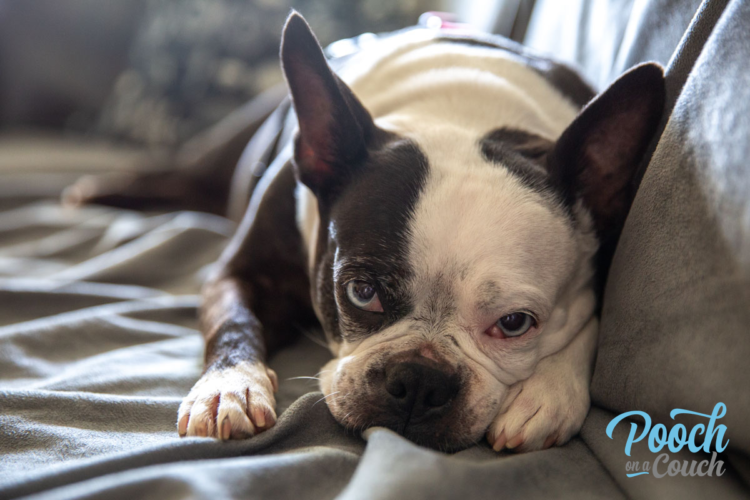If you are familiar with my blog, you already know I think you can learn a lot about your foster dog just by observing. What you see can help you retrain your rescue dog.
What we’ve learned is that Sassy Blue isn’t the same dog that left my home a year and a half ago. But she is. Let me explain.
Sassy And The Predicatble
Sassy is a dog that craves predictability and routine. That’s not necessarily an attribute.
We are advised to place our dogs on a routine the minute they arrive into our home. Routines and schedules are beneficial for dogs in a number of ways:
- Regulates digestive system
- Regulates sleep/wake/activity patterns
- Regulates bowel/bladder activity
- Provides consistency in training, communication, play, and relaxation
We re-train a rescue dog when we use routines. The problem comes when we take the term “routine” or “schedule” too serious and become rigid.
Dogs are creatures of habit, (we all are!!) and they need structure, not rigid schedules.
Inflexible dogs like Sassy have a hard time with change and are slower to adapt to differences in environment.
After 8 consecutive weeks of ordering Broccoli Chicken takeout on Tuesdays, the server at the Chinese restaurant looks at the patron and asks, "What's the matter? You don't like change?"
Re-training A Dog - Food Fighting?
The first clue was meal time. Sassy was used to her food being fixed a certain way, and when it wasn’t, she decided she wouldn’t eat it. Her former owner said, “Oh. I put a little water on her food.” An easy and healthy compromise. Water it is, Sassy Pants.
Along these same lines, Sassy now turns her nose up at fresh foods for treats. When Sassy left my home, she would eat apples, bananas, watermelon, carrots, blueberries, lettuce, and other fresh foods. She loved these treats, and now when you offer them to her, she rolls them around in her mouth and spits them out. She’s come to expect “healthy” store-bought treats, but while on a weight reduction plan, these are off limits.
It’s not a big deal if Sassy doesn’t like fresh fruits and vegetables anymore, it just means I have fewer options when wanting to give her treats.
Sassy's Re-training Plan
- If water makes Sassy happy, we’ll keep putting water on her food for now.
- We will vary feeding time. Sassy gets fed twice a day, but we will vary the exact time she’s given her food. Sometimes it will be 30 minutes early, sometimes it will be as much as 45 minutes late. I’ll change where she eats and from what bowl she eats.
- When she’s joined with Otis, we will use Otis as a model for behavior. Sassy learned to eat fruits and veggies before by watching Otis, I feel pretty sure we can get her to eat apples again!
- She no longer gets food rewards for behaviors that are expected. For example, she doesn’t need a treat for going outside to potty, walking nice on a leash, or displaying good manners.
Re-training A Dog - Driving Miss Daisy?
It took Sassy about three days to get her message across: “I go for a car ride every morning.” She was refusing to go for short little walks after potty (trying to up her exercise tolerance!) expecting to be driven for sightseeing.
Sassy's Retraining Plan
As you’ll see further down, she’ll get lots of car rides for the foreseeable future until I understand more about her anxiety. What she won’t get is a car ride every morning at 10:00 a.m.
She’s already begun choosing to wander the yard for a few short minutes after her morning potty.
Retraining A Dog - Putting Baby In A Corner?
Sassy has always been perfectly crate trained. You could leave her in her crate while you ran errands. She slept in her crate at night. (She preferred sleeping in the crate to sleeping in the bed with humans.) She never protested when asked to stay in her crate.
Not anymore. Her owners are against using closed-door crates. It is a personal decision, but my household is a crating household. When I leave my home, I prefer my dogs be crated. I know they are safe, secure, and content.
Of note, the one time her prior owners left her home loose and alone (no humans, no dogs) and behind a custom-built wooden baby gate, she damaged the gate.
While I’ll never insist Sassy stay in a locked crate (she is clearly anxious, panting, not able to rest) she is eating meals in her crate. Her crate is always open and available for her to use as a resting place. I hope that when she’s joined up with Otis and Carter that she will follow the crowd and decide that the crate is once again an OK place to be.
If she’s truly developed an aversion to crating and is dug in, we will adjust to her new ways. EmmyLou was a crate-aversive dog. It’s not the end of the world if Sassy can be calm and non-destructive while loose in the house.
Re-Training A Dog - Don't Leave Me!
Sassy is also demonstrating signs of separation anxiety or isolation intolerance, I’m not sure which. I’ll have to get down to her with my nanny cam to find out just how bad.
Sassy hasn’t been left alone in a year and a half. (except the one time mentioned above) She has never been an only dog, either, not in her whole life until the past two months. I don’t know and won’t know what the real source of her anxiety is until I get there and figure it out. For now, she’s left alone as little as possible, I don’t want to make her anxiety worse, putting her at risk for stress-related illness or physical injury.
Re-Training A Dog - Stormy Weather
Sassy is now anxious during thunderstorms. Even with distant thunder, she pants and paces and stands on her human’s chest! We bought new thundershirt to try. I will ask the veterinarian about OTC options before I ask for prescription medication, but if anti-anxiety medication is needed, we will use it! That’s what it’s for, my friends. In the meantime, the TV volume is up and we are trying to engage her in distraction games. Since she likes car rides, if the storms are not severe, we may take a drive. I’m really hoping we can get all of these anxieties turned around.
It goes without saying – we check in with the weather app on the phone OFTEN as Sassy is in an area prone to pop-up storms. Our goal is to get the environment right and supportive care on board BEFORE she hears the first rumble of thunder and becomes anxious.
Re-Train Your Dog To Be Flexible
I share Sassy’s struggles with you as food for thought. Dog anxiety has both a genetic and an environmental component. Science says so. I believe the less we ask our dogs to be flexible, the more rigid they become.
A wise trainer once told me, “you should change up your routine at home.” I’d been feeding the dogs at 5 pm on the dot, walking them at this time, leaving the house at that time, putting them in their crates for naps at a certain time.
This trainer’s point was: by being so predictable, I was limiting the opportunities for my dogs to practice being flexible or being adaptable and calm when change happened. Like if the food bowl was late or when it was raining outside and walks were not going to happen. When I needed them to go into their crates at the time I’d normally be taking them on a walk.
We laugh and call rigid dogs Divas when they act so demanding. In truth, it’s probably called inflexibility.
Try These Tips To Increase Your Foster Dog's Flexibility
Try these tips to increase your foster dog’s flexibility:
- Feed meals at different times, in different vessels, in different places. Have them work for their food sometimes by asking them to forage for it or use a food puzzle or a snuffle mat. Feed them in a different room.
- Have your foster dog practice being alone. (if they do not have separation anxiety) Have them practice being without humans and being without other pets.
- Take walks in different places, not just around your neighborhood. Get your dog used to experiencing new smells without becoming hyperaroused. It will polish those leash walking skills!
- If your home is normally filled with music, make it super quiet. Likewise, if your home is super quiet (like mine) play music (at a comfortable level for your dog’s ears) and let the dog experience some noise.
- If your dogs normally sleep in your bed, ask them to sleep in a crate beside your bed every so often. I ask Otis to do this! In the event you are evacuated or displaced due to an emergency, your dog will be much more adaptable if they have to be crated while in your temporary residence.
- Use baby gates even when you don’t have to. I cannot tell you how much better Otis (a nervous dog) has improved by asking him to “room up” behind a baby gate.
- Change the locations of your crates! On one occasion, I needed to ask a neighbor to come let Otis out of his crate three times while I was away on an extended day trip. His crate normally located in the den near the back door of the house, I moved it to the living room, closer to the front door, from where my neighbor would come and go. Otis DID NOT do well with this change, and was very anxious throughout the day. I felt horrible! A similar experience happened when trying to crate Otis in a hotel room while I went to grab a quick bite to eat. He didn’t tolerate being crated in new locations. I hope to begin traveling a little bit in the next couple of years and I’d like for him to come along. He and I have some practicing to do!
- Don’t come home directly after work, every day. Run an errand. Meet a friend. Go to the gym.
- Likewise, Don’t get up at the same time every morning. Your dog should let you sleep in when you want to!
Sassy's Test Results and Overall Health
Sassy’s allergies are much better controlled with antihistamines, regularly administered. We use Zyrtec at her recommended dose, given at bedtime when her symptoms are worse. Her poop’s color and consistency improved and looks less “fatty”. Her cherry eye went back in and only popped back out during her anxiety with the most recent thunderstorm. We need to re-weigh her, so I don’t know how much weight she’s lost this week. I finally received a good photo of her whole body and noticed just how alopecic she is. She’s quite bald on her belly, the sides of her body, her inner thighs, and around her rear end. Hair loss like this is a symptom of many things, including hypothyroid.
Here’s the kicker: Her thyroid panel was WITHIN NORMAL LIMITS!
She DOES NOT have hypothyroid!
Total shocker. I’ve known that the T4 thyroid level can be influenced by many factors, including other illnesses or various stressors. In a dog that looks and is otherwise healthy, it’s not unreasonable to take a wait and see approach and re-test in the future. (Always talk with your veterinarian about the best approach.) However, Sassy LOOKS hypothyroid. She looks like a sausage with legs, and her hair is falling out. She acted hypothyroid, inert, low energy.
We could have not done the extra testing. It was not a cheap test, well above $100 even with a discount afforded the rescue organization. We could have a) treated her with medications based on the T4 level alone and ultimately treated her for a condition she didn’t have, or we could have b) waited 6 months, retested her and still spent about the same amount of money in testings.
Because I knew much of Sassy’s history, I opted to test now.
I don’t know why she’s so much more obese than any of the other dogs that were in that home, and I don’t know why she’s hairless. Steroids may be to blame. Allergies and her immune system may be to blame. Stress from an overbearing puppy and a permissive home may be to blame. I even read an article where dogs that don’t get a lot of outdoor sunlight (like during the winter months in the north) can develop patterned hair loss. Sassy’s owner had been told by her veterinarian that Sassy was at risk for developing cancer on her nose. (I’m investigating this further as Sassy does have blue eyes and a clown face) It is possible Sassy wasn’t allowed to stay outside very long.
Sassy has free access to the sun porch and lays in the sun for just a minute or two before she moves into the shade. Maybe it will help her, but it sure isn’t hurting her.
Otis Update
Otis and I have a checkup with his veterinarian tomorrow. There seems to be less of a pocket of fluid around the lymph node, but I’m not skilled in assessing if the lymph node is smaller or the same. There are a lot of unknowns and many potential diagnoses still on the table.




